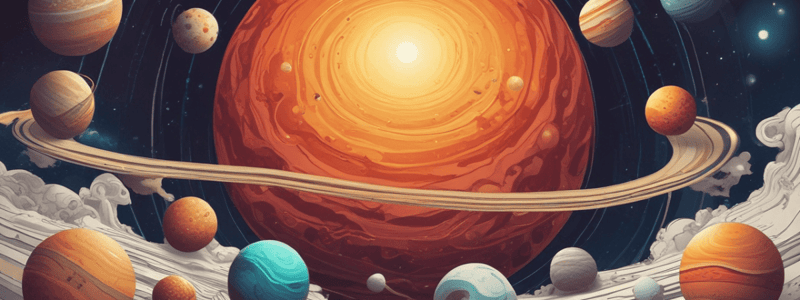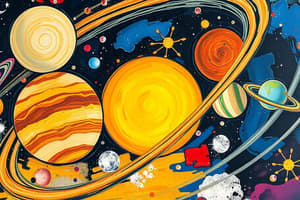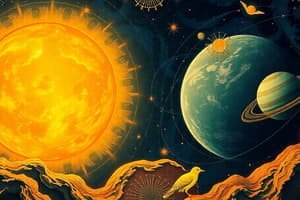Podcast
Questions and Answers
Which planet is known for experiencing extreme temperature variations due to its proximity to the sun?
Which planet is known for experiencing extreme temperature variations due to its proximity to the sun?
- Venus
- Mars
- Uranus
- Mercury (correct)
Which mnemonic is used to remember the order of the planets in our solar system?
Which mnemonic is used to remember the order of the planets in our solar system?
- My Very Educated Mother Just Served Us Noodles (correct)
- My Vexed Enraged Mother Just Served Us Noodles
- My Virtuous Educated Mother Just Served Us Noodles
- My Very Energetic Mother Just Served Us Noodles
What distinguishes Jupiter from all other planets in the solar system?
What distinguishes Jupiter from all other planets in the solar system?
- It is the furthest from the sun.
- It has rings surrounding it.
- It is the hottest planet.
- It is the largest planet. (correct)
Which of the following planets is known for its stunning rings?
Which of the following planets is known for its stunning rings?
What is a characteristic of the sun?
What is a characteristic of the sun?
What are constellations made of?
What are constellations made of?
Which planet is known for its reddish color and dusty surface?
Which planet is known for its reddish color and dusty surface?
What is the primary reason caution is advised when viewing the sun directly?
What is the primary reason caution is advised when viewing the sun directly?
What does the moon do with the light it receives from the sun?
What does the moon do with the light it receives from the sun?
Which of the following best describes an astronomer?
Which of the following best describes an astronomer?
Flashcards are hidden until you start studying
Study Notes
Our Solar System Overview
- The solar system consists of eight planets that revolve around the sun.
- Each planet has its own characteristics and unique features.
Planets in Order from the Sun
- Mercury: Closest to the sun; experiences extreme temperature variations, hot during the day and freezing at night.
- Venus: Harsh climate; hot, dry, and windy conditions with no rain.
- Earth: Third planet from the sun; spins continuously, creating day and night cycles. Humans live here.
- Mars: Known for its reddish color; surface is covered with dust, leading to its rust-like appearance.
- Jupiter: Largest planet; its mass is greater than all other planets in the solar system combined.
- Saturn: Famous for its stunning rings; light enough to float in water.
- Uranus: Surrounded by many satellites; unique for its blue color.
- Neptune: Farthest from the sun; known for its striking blue appearance.
Mnemonic for Remembering Planet Names
- Use the phrase: "My Very Educated Mother Just Served Us Noodles" where each word corresponds to a planet:
- Mercury
- Venus
- Earth
- Mars
- Jupiter
- Saturn
- Uranus
- Neptune
Stars and Constellations
- Stars appear small but are actually massive glowing spheres.
- Constellations are patterns made by stars, including recognizable figures like:
- The Great Bear
- Leo the Lion
- Taurus the Bull
- Orion the Hunter
The Sun
- The sun is the closest star to Earth and essential for life.
- Approximately one million Earths could fit inside the sun.
- Direct viewing can harm the eyes; caution is advised.
The Moon
- The moon does not emit its own light; it reflects the sun's light.
- Astronauts have explored the moon, using a specialized vehicle called a lunar rover.
Key Terms
- Astronaut: Individual who pilates spacecraft or works in space.
- Astronomer: Scientist studying celestial bodies.
- Lunar Rover: Vehicle used to navigate the moon's surface.
- Satellite: Object that orbits a planet; can be natural (like moons) or artificial.
- Telescope: Instrument for viewing distant celestial objects.
- Solar System: Includes the sun and all orbiting planets and bodies.
- Universe: Encompasses all matter, including planets, stars, and all of space.
Final Thoughts
- The universe remains largely unexplored, and future discoveries await.
- Engaging with stories and books fosters curiosity about space at any time of the day.
Our Solar System Overview
- Eight planets revolve around the sun, each with unique features and characteristics.
Planets in Order from the Sun
- Mercury: Closest planet to the sun, with extreme temperature fluctuations—hot days and freezing nights.
- Venus: Features a harsh, dry climate with high temperatures and constant winds; receives no rainfall.
- Earth: Third planet; rotates continuously, resulting in day-night cycles; supports human life.
- Mars: Known as the "Red Planet" due to its reddish appearance, caused by rust-like dust covering its surface.
- Jupiter: The largest planet in the solar system, with a mass greater than all other planets combined.
- Saturn: Renowned for its beautiful rings; has low density, allowing it to float in water.
- Uranus: Unique blue color and numerous moons; distinguished by its tilted rotation axis.
- Neptune: The farthest planet from the sun; recognized for its striking blue color.
Mnemonic for Remembering Planet Names
- The phrase "My Very Educated Mother Just Served Us Noodles" aids in recalling the planets in order.
Stars and Constellations
- Stars are enormous glowing spheres despite their small appearance from Earth.
- Constellations are patterns formed by stars; examples include:
- The Great Bear (Ursa Major)
- Leo the Lion
- Taurus the Bull
- Orion the Hunter
The Sun
- The nearest star to Earth, critical for sustaining life.
- Capable of containing approximately one million Earths within its volume.
- Direct exposure to sunlight can be harmful to eyesight; protective measures are essential.
The Moon
- Reflects the sun's light, does not emit its own.
- Explored by astronauts using lunar rovers, specialized vehicles designed for the moon's terrain.
Key Terms
- Astronaut: A professional trained for space missions and operations.
- Astronomer: A scientist devoted to studying celestial bodies and phenomena.
- Lunar Rover: A vehicle specifically designed for traversing the lunar surface.
- Satellite: An object orbiting a planet, can be natural (like moons) or artificial.
- Telescope: An instrument for observing celestial objects at great distances.
- Solar System: Encompasses the sun and all celestial bodies in orbit around it.
- Universe: Includes all matter, energy, planets, stars, and vast expanses of space.
Final Thoughts
- The universe is predominantly unexplored, with ongoing opportunities for future discoveries.
- Engaging with literature and stories can ignite curiosity about space at any time.
Studying That Suits You
Use AI to generate personalized quizzes and flashcards to suit your learning preferences.


